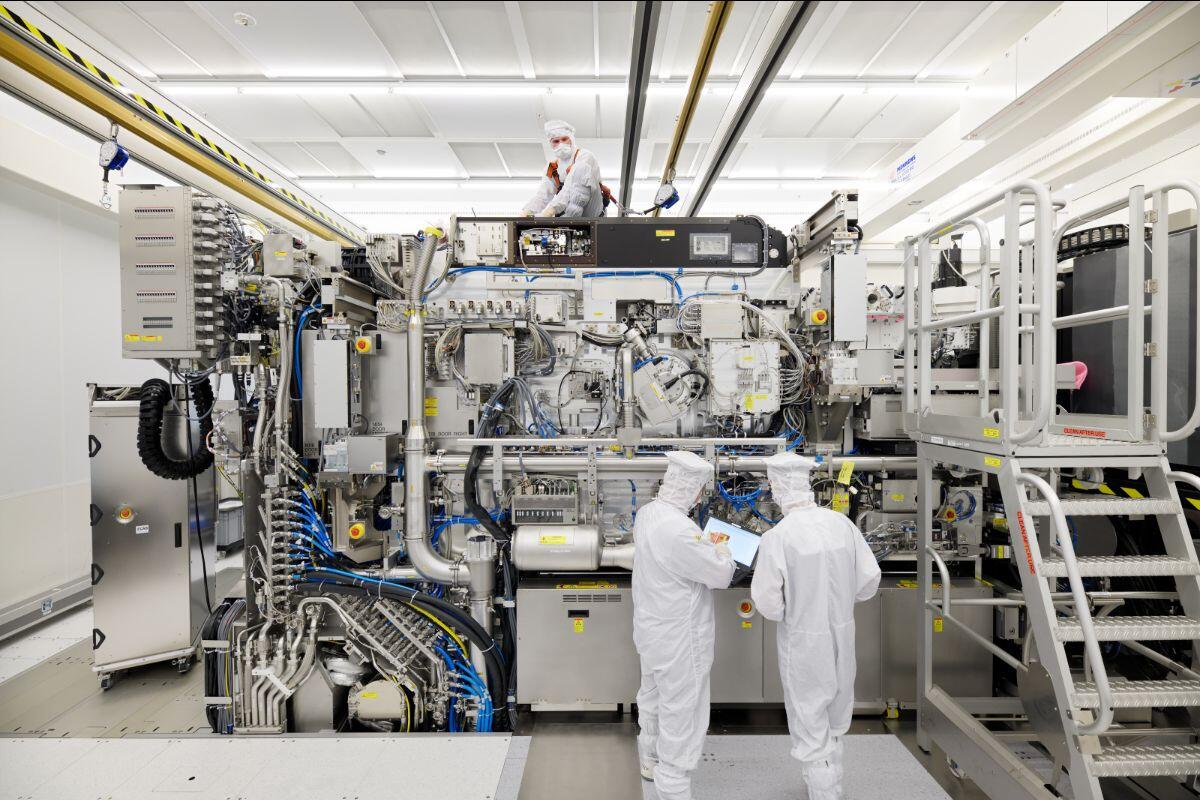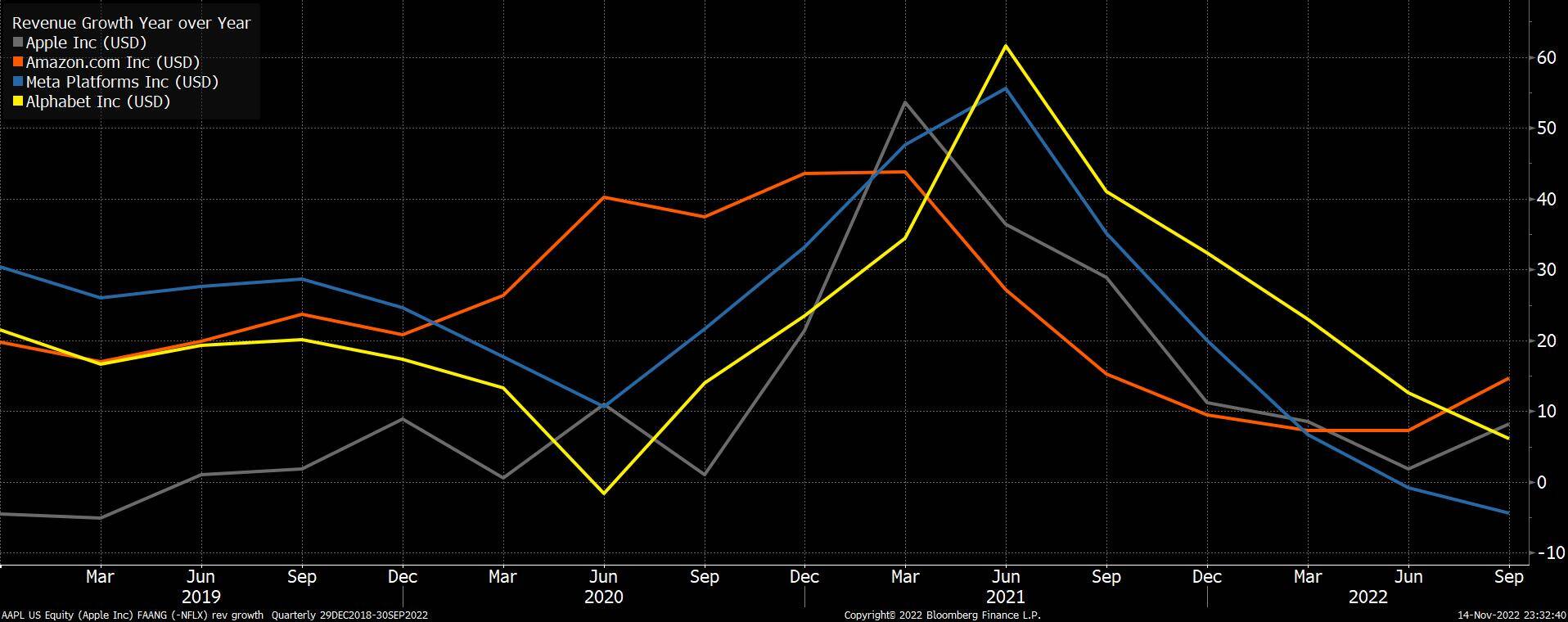
Since the beginning of the year, the dominant narrative across the semiconductor industry has been that chips are entering a cyclical downturn with revenues and earnings expected to fall as the industry enters a post-pandemic supply glut. Investors have been pricing this in for months, with the Philadelphia Semiconductor Index (SOX) falling more than -40% from its peak in November 2021 to the end of October 2022.
We acknowledge there are some end-user markets, like smartphones and PCs, that are experiencing headwinds due to inflation and recessionary pressures, but the countervailing factor is that the scope of applications for semiconductors continues to expand very significantly.
Earlier this month ‘long-dated’ stocks had their biggest single one-day move since April 2020, a result of a lower-than-expected inflation number implying more muted rate rises into 2023, and possibly even some rate cuts. Goldman Sachs called it a ‘bear squeeze’ – meaning that investors were forced to cover positions at prices much higher than they had expected only days earlier.
It was over these couple of days (10/11 – 11/11) that the Fund appreciated 8.4%, which was outperformance of +6.2% relative to the benchmark. A significant proportion of this movement stemmed from the Fund’s semiconductor holdings, which performed strongly because of the integral part they play in an increasingly digitised and connected world. While the Fund has since given back some of those relative gains, we believe it highlights the negativity baked into expectations and how quickly the market can turn on signs of an improving macro.
ASML, the company that makes the machines that make the chips
 Source: ASML
Source: ASML
One company essential for the manufacture of semiconductors is the Dutch group ASML Holding BV, which has a (competitive) monopoly on the production of the extreme ultraviolet lithography machines required for the patterning process in semiconductor fabrication.
These machines are highly complex, costing hundreds of millions of dollars each and taking months to build by a specialised team in the Netherlands. ASML produces only tens of these each year for a limited customer base, including the largest semiconductor fabricators: TSMC, Samsung and Intel, giving it a unique insight into the fundamentals driving the industry.
The company reported its third quarter earnings in mid-October, delivering a beat on both revenue and earnings, raising its forward guidance for the current quarter and rallying almost 20% toward the end of the month. CEO Peter Wennink noted in the ASML earnings call that the company continues to grapple with a shortage of materials to produce these machines, saying “there’s still such a big gap between the demand side and what we can (physically) make”. He estimated the current order backlog to stand at $38 billion with delivery delayed until 2023 as customer demand far outstrips supply, even in future quarters. This backlog is almost twice as large as the company’s revenues for the last twelve months. When questioned on the source of chip demand, Wennink said “Not one firm on the planet actually has the full insight into where all these chips are going”.
Any decreased semiconductor demand for smartphones and PC’s is being taken up by data centres, with autos, industrial (ie connected devices) and energy additive.
Take the automotive industry for example, the dollar value of the silicon content in premium cars was just 4% in 2019 and will be an estimated 20% by 2030 (per Intel). This is uncontroversial, given the substantial uplift in the technological requirements of cars such as additional safety features like lane-trace and exit warnings, autonomous braking, collision warning, park-assist along with a litany of other entertainment and driver comfort features, all of which require sophisticated semiconductors to power these functions.
This secular tailwind the semiconductor industry is currently experiencing is misunderstood by a market which views semiconductors as limited to phones and computers and cyclical in nature. The sheer scope of end markets for semiconductors is increasing at a near exponential rate and the Fund is poised to take full advantage of this multi-decade course.
Weak macro dampens third quarter earnings
October saw another quarter of earnings results, with investors continuing to closely monitor for clues on how the Federal Reserve’s aggressive interest rate tightening is impacting corporate America. Alphabet (Google), Amazon and Meta (not held by the Fund) in particular were punished by investors for not making serious enough efforts to control costs given slowing revenue growth and a deteriorating macro. It didn’t help that the guidance provided by these companies (some of the world’s largest) pointed to an even bleaker picture for the fourth quarter.
Amazon and Alphabet (Google) grew revenues at +15% and +6% year-over-year, respectively. Meanwhile, Apple grew revenues at +8% year-over-year. Many in the media have been quick to join the ‘big tech’ pile-on, pointing to slowing growth and falling share prices as the end of an era. We’re a little more optimistic for a few important reasons.
Firstly, there is a large foreign exchange component in these growth rates as a result of a significant appreciation in the US Dollar, which negatively impacts revenue derived from non-US regions (these are global businesses after all). To better understand the underlying strength of these businesses we must look at revenue growth on a constant currency basis: on this measure, the picture is a little more rosy than at first glance, with revenue growth for Amazon, Alphabet and Apple of 19%, 11% and 14% year-over-year, respectively.
These growth rates are being achieved on top of already elevated levels brought about by the pandemic, at which time they were a source of crucial products and services to a locked-down world. To be sure, some level of trend normalisation was in order. But a lot of the pandemic-era revenue is sticking – and still growing. Despite most of the FAANG now trading back to or below pre-pandemic share prices (Apple is the only exception), all of the companies have held onto their pandemic-era revenue gains and are continuing to exhibit growth. Given the elevated base and an increasingly uncertain macro, a period of lower growth is unsurprising.
 Revenue growth rates of Apple, Amazon, Meta and Google (quarterly, year-over-year)
Revenue growth rates of Apple, Amazon, Meta and Google (quarterly, year-over-year)
Source: Bloomberg
Finally, while it’s easy to say that the best share-price years are behind these companies a more detailed analysis is in order. Why shouldn’t e-commerce penetration (currently sitting at just above 20% in the US) continue to increase to the benefit of Amazon? In an increasingly digital world online advertising will continue to grow (whether it’s search, mobile or CTV) to the benefit of Alphabet. Both Amazon and Alphabet will benefit from their investments in Cloud capacity as IT (and increasingly non-IT) services move to the cloud. And Apple will continue to leverage its 1 billion + user base to drive growth in its high-margin services business (with added optionality in mixed reality and autos).
In volatile times like these it is crucial to disentangle structural (disruptive) forces from cyclical (macroeconomic) ones, because business cycles come and go, but disruption can drive value over multiple decades. Due to the strategy’s focus on quality, we have a high degree of confidence in our portfolio companies’ ability to withstand a difficult business cycle.
Featured Image Source: Kiersten Essenpreis for Money
Share this Post


